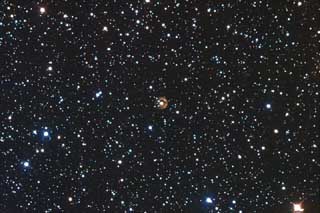Presenting what could possibly be a once in a lifetime opportunity on a new class of object, V838 started out as an enigmatic explosive variable star, first discovered on film images on January 6th, of this year. Since then an amazing series of events has occurred. The brightness peaked four times over a period of four months, peaking at around 9th magnitude. The progenitor star was a F0 main sequence star, and has transformed into a M8 class giant star in just a few months. The papers I've come across on this object indicate that this is a new type of astronomical object on record: Main sequence stars that erupt into cool supergiants. The golden brownish ring you see here formed shortly afterwards and is not a normal nebula as such, but a "light echo" from dust surrounding the star traveling at an apparent super luminal velocity. It is identical in nature to the rings round SN1987a in the LMC. I will be photographing this object on a routine basis, and hope to assemble a sequence over the next few years of its growth and changes. The object is located around a faint star, at Megastar limit of 16 at: RA 07 04 05 DEC -03 50 51 in the constellation of Monoceros, near the Rosette nebula. It SHOULD be possible to see it visually in a moderate sized amateur instrument, since I could plainly see it with a 1 second exposure on the CCD readout. I have included a full size image for those with high resolution monitors, since there is plenty of small details in this object to be seen. Processing: Calibration in Maxim DL, Deblooming - Wodaski's Debloomer, Summing of subframes - Gralaks Sigma, RGB combine - Maxim, LRGB - Photoshop. Instrument: 12.5" f/5 Home made Newtonian Platform: Astrophysics 1200 QMD CCD Camera: SBIG ST8i Guider: SBIG ST4 Exposure: LRGB = 60:10:10:20 (RGB Binned 2x2) RGB Combine Ratio: 1: .8: 1.2 Filters: RGB Tricolor Location: Payson, Arizona Elevation: 5150 ft. Sky: Seeing FWHM = 4.0 arcsec (Maxim DL - 10min subframe), Transparency 8/10 Outside Temperature: 5 C CCD Temperature: -20 C Processing: Maxim DL, Photoshop, AIP4WIN, PW Pro, Wodaski Debloomer
|
||||
|
|
||||
|
FastCounter by bCentral |
